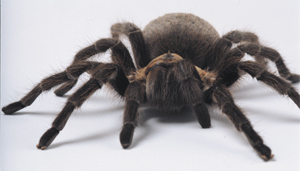How to Keep Spiders as Pets
Spiders can make fascinating pets. Here are a few steps to get you started keeping spiders.

Step 1: Catch a spider
Spiders are all around us, indoors and out, so they’re not hard to find. Some species can bite and a few are venomous. Learn about dangerous spiders in your area before heading out. It’s easy to safely catch a spider by using a small jar. Gently coax it into the jar using the lid. Spiders will eat each other, so keep only one per jar.
Step 2: Prepare a cage
Large spiders do well in the inexpensive plastic terrariums available from pet stores. Smaller ones can be kept in jars or plastic containers if air holes are drilled into the lid or sides. Be sure the holes are small enough to prevent escape.
Potting soil makes good cover for the cage bottom. Sticks, dead leaves or artificial plants provide structure for hiding, climbing and webbing.
Step 3: Water
Depending on the size of the spider, anything from a plastic bottle cap to a small bowl can serve as a water dish. Spiders also drink water sprayed on webbing, but you should never allow the cage to become damp.
Step 4: Feeding
Offer insect prey once or twice a week. Crickets are available from pet shops, or you can collect insects outdoors if no insecticides have been sprayed in the area.
Step 5: Observing
Watch your spider and take notes on its behavior. You won’t believe what happens in the spider’s web until you’ve visited it yourself!
PREFERRED PETS
 Not all spiders do well in captivity. Active hunters are usually easier to keep than web builders. Here are a few that make good pets.
Not all spiders do well in captivity. Active hunters are usually easier to keep than web builders. Here are a few that make good pets.
Tarantulas: Some species exceed 10 inches in legspan. They’re by far the most popular pet spiders and can be bought in pet stores.
Wolf Spiders: Some can be more than three inches in legspan. Large specimens do best in terrariums with lots of floor space.
Jumping Spiders: Although small and rarely exceeding half an inch, their jumping ability is amazing. Many species are brightly colored and can easily be kept in jars.
Fishing Spiders: In captivity, these large spiders appreciate vertically arranged pieces of bark for climbing. They’re very fast, so use caution when capturing them.
Grass Spiders: These spiders build funnel-shaped webs in grass, bushes and on buildings. In captivity, they will build extensive webs inside their cage.
LEARN MORE: Click here to see photos of a spider expert’s seven favorite spiders
I just caught a spider today and I really need some help. It is a meduim sized spider and it is furry. I would like to know what type of spider it is , if it is poisonous , and what sized tank it needs. If you know any of the questions answers please type them right away. Thankyou
I caught a velvet spider a few days ago and would like to know if I can keep it as a pet? it’s really fascinating to watch!!! It’s already eaten one bug and spinning all over the place. The spider’s in a container with holes and I’ve put some sand, bark, a rock and leaves in it. How much space does this spider require and I’d also like to know if it’s venemous?
Spiders ROCK
This would be LOTS of fun.
Are Writing Spiders good to keep as pets???
hey i just got a funnel web spider in a small enclosure. how do i give it water other than a bottle cap. the enclosure is to small for that and it would fall in
I have a pet spider she lives outside I feed her evey week.
I keep two or three daddy long legs, but I let them be free, I love watching them.
Wait until you leave home, or keep them outside some where, maybe in a shed.
I had a pet black widow outside my house near the beach. She laid her eggs, it was crazy!!!! There were a million little baby spiders running across a web on the top of my grill. It was so cool to see her every night, sometimes I’d be worried when I wouldn’t see her so she wouldn’t bite me but she was just hunting. I had to let her go because we moved but I bet she still lives there! I also had another pet spider at the same location but after the San Diego fires it went missing, that sukka was HUGE!!!